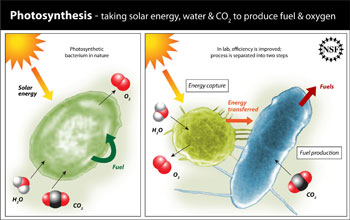Multimedia Gallery
Overcoming Limitations in Photosynthesis
In photosynthesis, solar energy is captured and used to produce chemical fuel by a photosynthetic organism. The research in this National Science Foundation-supported project is designed to improve the efficiency of this capture and conversion by: 1) separating them into two types of cells, one that captures solar energy and another "factory" cell that produces fuel; and 2) enabling these two different types of cells to communicate with one another via the flow of electrical currents between them. Compartmentalizing the processes of energy capture and fuel production into two different types of cells will allow researchers to optimize environments for each process, and thereby improve the efficiency of each process.
To learn more, see NSF press release "NSF Announces New Awards That Will Investigate More Efficient Ways to Harvest Sunlight to Make New Biofuels and Biomaterials."
Credit: Zina Deretsky, National Science Foundation
Images and other media in the National Science Foundation Multimedia Gallery are available for use in print and electronic material by NSF employees, members of the media, university staff, teachers and the general public. All media in the gallery are intended for personal, educational and nonprofit/non-commercial use only.
Images credited to the National Science Foundation, a federal agency, are in the public domain. The images were created by employees of the United States Government as part of their official duties or prepared by contractors as "works for hire" for NSF. You may freely use NSF-credited images and, at your discretion, credit NSF with a "Courtesy: National Science Foundation" notation.
Additional information about general usage can be found in Conditions.
Also Available:
Download the high-resolution JPG version of the image. (245 KB)
Use your mouse to right-click (Mac users may need to Ctrl-click) the link above and choose the option that will save the file or target to your computer.



